 April is Maryland Archaeology Month. On Saturday, I joined the local archaeological group, providing activities for children to learn how we can study the past by examining the items people left behind. Most of them asked, “Like their trash?” I suppose that is one way of looking at it.
April is Maryland Archaeology Month. On Saturday, I joined the local archaeological group, providing activities for children to learn how we can study the past by examining the items people left behind. Most of them asked, “Like their trash?” I suppose that is one way of looking at it.
Archaeological digs can be found throughout history. Some of the first cultures interested in learning more about their past include Egyptians, Mesopotamians, Greeks, and Romans. However, these were more about finding treasure than scientific exploration.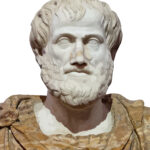
During the Renaissance, there was renewed interest in the classical world, and the study of ancient texts became a hobby for many. While digging for artifacts now followed a more systematic approach, these were little more than treasure hunts. During the 18th and 19th centuries, it became fashionable for young men to on The Grand Tour searching for ancient art.
In the 19th century, archaeology emerged as a discipline, though treasure hunters still existed. This new breed of archaeologists used methods such as stratigraphy, or the study of the artifact’s context in the layers of sediment, to interpret ancient sites. These discoveries captured the imagination of the public. Some were displayed in museums, but many remained in private collections.
 By the beginning of the 20th century, archaeology became a bit more professional with advancements in excavation techniques. We begin to see scientific methods, such as carbon dating, employed, as well as the increase in pottery experts. Institutions devoted to archaeology sprang up.
By the beginning of the 20th century, archaeology became a bit more professional with advancements in excavation techniques. We begin to see scientific methods, such as carbon dating, employed, as well as the increase in pottery experts. Institutions devoted to archaeology sprang up.
During the 20th century, the focus shifted to understanding the cultural and chronological history of past societies. That led to new cataloging and classification methodologies by periods and traditions. However, this did not consider the broader questions of social, economic, and environmental factors.
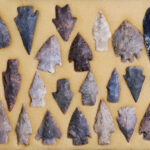
Beginning in the 1960s, the science of archaeology saw a paradigm shift emphasizing the understanding of past societies as dynamic systems affected by social and environmental factors. Methods using ecological modeling and analysis of settlement patterns emerged. By the late 20th century, emphasis was placed on the subjective nature of archaeology and the importance of understanding the past from multiple perspectives.
Current archaeology is characterized by a variety of approaches and new techniques. Remote sensing, such as ground-penetrating radar, and DNA analysis, has revolutionized the field. It is now possible to reevaluate old questions and ask new ones. There is a growing interest in collaborative and community-based research.
In short, archaeology has grown from a treasure-hunting hobby to a rigorous scientific discipline for understanding human civilization, who we are, and how we got here. The field has come a long way, but not without its pitfalls.
If you’ve ever watched the British show Time Team, you will have heard them lament the sites where antiquarians previously excavated. One downside to the investigations was the early tomb raiders. In their quest for valuable finds, they did irreparable damage to historic sites by engaging in destructive methods, such as dynamite and tunneling, which caused collapse. These methods destroyed valuable archaeological context.
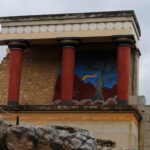 And sometimes, they got it wrong. In 1900, archaeologist Arthur Evans began excavations on what he believed to be the palace of King Minos on the island of Crete. He dug at Knossos for over twenty years, uncovering a vast complex of buildings and exquisite artifacts. From these findings, he theorized Minoan culture as peaceful and prosperous. However, as we discovered when we visited the site while we lived on Crete, his conjectures were based on his experience with Roman sites. Critics claim he projected his preconceived notions of Minoan life onto his reconstructions, reflecting his own biases and preferences. And some believe he got it wrong.
And sometimes, they got it wrong. In 1900, archaeologist Arthur Evans began excavations on what he believed to be the palace of King Minos on the island of Crete. He dug at Knossos for over twenty years, uncovering a vast complex of buildings and exquisite artifacts. From these findings, he theorized Minoan culture as peaceful and prosperous. However, as we discovered when we visited the site while we lived on Crete, his conjectures were based on his experience with Roman sites. Critics claim he projected his preconceived notions of Minoan life onto his reconstructions, reflecting his own biases and preferences. And some believe he got it wrong.
I will admit we found a few things that didn’t feel right. In particular, for me, was the area Evans defined as a theatre. As one who studied theatre history, I found the location odd. At Knossos, there is an intersection at the top of a hill where stairs descend from different directions to a square opening onto a lower road leading to the harbor. Evans identified this staircase as a theatre. Experts, over time, are not sure what type of events would have been held there, though one presumes it was a place to greet important visitors arriving by water. Greeks typically used natural hillsides to construct their theatres, unlike the Romans, who built large buildings of brick and stone. I guess we’ll never know for sure.
found the location odd. At Knossos, there is an intersection at the top of a hill where stairs descend from different directions to a square opening onto a lower road leading to the harbor. Evans identified this staircase as a theatre. Experts, over time, are not sure what type of events would have been held there, though one presumes it was a place to greet important visitors arriving by water. Greeks typically used natural hillsides to construct their theatres, unlike the Romans, who built large buildings of brick and stone. I guess we’ll never know for sure.
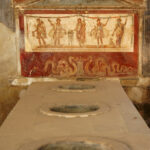 I’ve always had an interest in history, so when I had the opportunity to help with the Pompeii Food & Drink Project while living in Naples, I jumped at the chance. This project was not a dig but an investigation into the eating and drinking habits of the people of Pompeii, a town frozen in time in August 79 AD. We examined spaces such as kitchens and triclinium (dining rooms) in homes, restaurants, and even ‘fast-food’ vendors at the arena.
I’ve always had an interest in history, so when I had the opportunity to help with the Pompeii Food & Drink Project while living in Naples, I jumped at the chance. This project was not a dig but an investigation into the eating and drinking habits of the people of Pompeii, a town frozen in time in August 79 AD. We examined spaces such as kitchens and triclinium (dining rooms) in homes, restaurants, and even ‘fast-food’ vendors at the arena.
Years later, many of the same people were excavating the site of a Roman domus, or town home, on the island of Malta. The goal here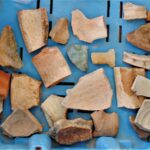 is to connect this wealthy home to the city nearby. I joined that dig for the past two years as we searched to place the house in context to its surroundings. Unlike the ancient antiquarians, I love the small items, the things used by people on a daily basis. I was excited by some of my finds. My favorites were the diagnostic pieces, those that you can readily identify, such as pot rims and jug handles. The first year, I even found a large section of a pinch pot, an oil lamp formed by pinching the clay rim into shape. This past year, we found a previously unknown house set in an area of shops. The artifacts there included a comb carved from bone.
is to connect this wealthy home to the city nearby. I joined that dig for the past two years as we searched to place the house in context to its surroundings. Unlike the ancient antiquarians, I love the small items, the things used by people on a daily basis. I was excited by some of my finds. My favorites were the diagnostic pieces, those that you can readily identify, such as pot rims and jug handles. The first year, I even found a large section of a pinch pot, an oil lamp formed by pinching the clay rim into shape. This past year, we found a previously unknown house set in an area of shops. The artifacts there included a comb carved from bone.
 Unfortunately, I am unable to return this year and will miss it. But, to console myself, I am taking part in excavating a home near Oldtown with the Archaeological Society of Maryland. This dig has a dual interest for me as my Howell ancestors are from the area. And the home? It is the fortified residence of Thomas Cresap, a character in Death on the Line.
Unfortunately, I am unable to return this year and will miss it. But, to console myself, I am taking part in excavating a home near Oldtown with the Archaeological Society of Maryland. This dig has a dual interest for me as my Howell ancestors are from the area. And the home? It is the fortified residence of Thomas Cresap, a character in Death on the Line.
Archaeologists are always learning. Who knows what man will learn in the future? A museum in Germany had a display with just that sentiment. In a picture, there was a crushed soda can and a piece of tire. The captions read:
“Sensational archaeological finds from the 20th century reveal their secrets.”
A round, thin-walled receptacle believed to be a drinking vessel. Found worldwide. The outer surface shows fragments of red paint with the letters O, L, and A, which have not yet been interpreted. An interior analysis revealed an industrially manufactured drink containing caffeine and sugar.
The other described a black, extruded rubber flexible lining believed to have been from the wheel of the transportation boxes used at the time, which were propelled by primitive combustion engines.
If you were an archaeologist of the future, what would you find from 2024?
